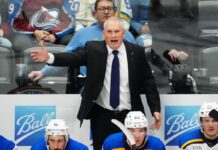At the start of 2023 development camp, Assistant General Manager and head of player development Hayley Wickenheiser discussed the transition from working under Kyle Dubas to working under Brad Treliving, her initial impressions of 2023 draft selections Easton Cowan and Noah Chadwick, and provided progress updates on a number of other players in the Leafs prospect pool.
How has Kyle Dubas moving on affected you or your role?
Wickenheiser: So far, my role is the same. I loved working with Kyle. First off, he is an incredible human being — a good person — and I think we would all say that here in Toronto. Certainly, he was great to me just being able to manage the demands of medical school and everything that goes with what I was doing.
It is a business. It is the nature of the business. I often say you are hired to be fired in the NHL. It is very hard, when you get close to people, to see them go, but with a new change coming in with Brad… Being from Calgary, I didn’t know Brad well, but I knew a little bit of Brad through the years. It has been a really good start with him. He is a good person to work with.
He is bringing a little bit of a different twist, but a change sometimes is good. It is good for everyone to adapt, and that is part of winning and being in this business. Change is inevitable, and it is about how you go with it. It has been an enjoyable transition, I guess, but I have a lot of respect for Kyle as well.
What are your first impressions of Easton Cowan?
Wickenheiser: I really like Easton. There is something about him that sort of speaks to… He has an internal fire about him with him being a smaller player, playing junior B, and getting drafted higher than maybe people thought. He is a very modest kid and a farm boy.
A lot of credit to him for being able to make the London Knights — and not only that but as a 17-year-old, killing penalties and the number of important minutes that he played at the end of the season. Had his team gone to the Memorial Cup, we might have seen an even bigger impact.
He is a player that we really like. He is really easy to work with and open to coaching.
What have you made of Roni Hirvonen’s progress? What have you noticed about his progression from his draft year a few years ago until now?
Wickenheiser: I think he has made significant progress. Really, the credit goes to Roni. He has been very open to the ideas that we throw at him from the development staff. We have changed a little bit with his posture, his stick, and his approach to the game.
He is a more confident guy. He is more powerful and explosive. He had a very long season last year when he played almost 11 months. He is catching up off the ice in terms of conditioning and training, which will be the biggest thing for Roni. He is a competitor. He has a good head on him. He sees the ice fairly well.
What are the biggest challenges for Hirvonen coming over from Finland to North America?
Wickenheiser: The smaller ice surface might actually be more beneficial for the way Roni plays. On the bigger ice surface, he is not a skater that really lights it up in the open ice, but coming out of the corners, in the first two or three steps, being able to play around the net and play tight, are areas he can excel in. He doesn’t shy away from contact. He proved in the World Juniors that he is a competitor and a good leader.
I think it is just his comfort level and the belief in himself that he is capable of getting to that level and really digging into it every day.
After a year with the Marlies, what are you hoping to see from Topi Niemela this summer and fall?
Wickenheiser: Playing in Oulun, it was a very defensive system that they had this year in Finland. Coming to the Marlies, he talked about the ability to get up the ice and make plays. We all know that he is an elite playmaker. He makes a great first pass. He was able to contribute on the power play and step in pretty effectively with the top-four D with the Marlies.
For him, it comes down really similar to Roni. They play a lot. They skate a lot. The next step will be their physical conditioning and strength to be able to win retrievals on pucks and handle the contact and physical play that comes with the AHL.
With Fraser Minten, where do you see the areas for improvement?
Wickenheiser: We have seen a little bit of growth in him already in terms of his strength and explosivity. He is starting to fill into the frame that he has, which is a pretty good frame to put mass on. He has a really tricky release and a good release.
I think it is just about evolving his tenacity and assertiveness with the way he plays the game to be able to dominate more in different areas of the game. When he steps out on the ice, the other guys have to know he is out there and he can hurt you at the WHL level.
It is more of a mentality for Fraser and then continuing to expand on his physical development.
What do you want to see from Nick Moldenhauer as he heads to the University of Michigan?
Wickenheiser: With Nick stepping into the NCAA program, it’s just continuing to make plays at that level and expand his game. He is very explosive. He skates well and shoots the puck well. At the next level, it’s being able to dominate at the NCAA level and make players around him better all the time.
It feels like Michael Koster’s game has taken some steps this year. Have you seen that?
Wickenheiser: Yeah, we did. I think Mike has quietly evolved and evolved into a pretty steady, reliable player at Minnesota. Certainly, watching him out here, his mobility has improved with his strength and explosivity. Just being able to dominate on the power play and be an important part of their program is key for him.
What does Ty Voit need to do to translate his playmaking to the AHL this season successfully?
Wickenheiser: With Ty, it is not so much about his ability to make plays. We all know he can do that. It is his ability to physically be able to compete every day and to be able to handle the pace and physicality that the AHL brings.
He has a really good sense for the game. He is crafty in the way that he approaches it. It will just be about whether he can manage… Obviously, he is an undersized player, but what he has been able to do in Sarnia last year was impressive with 100 points. It is a much different game at the AHL level. He is going to have to be able to play both ends of the ice a little bit more than he did in Sarnia.
How can a play like Joe Miller turn the lack of size into an asset for his game?
Wickenheiser: You see today that he is a great skater and a very skillful player. At the next level, for players that are undersized, it is just the ability to be able to play in the middle of the ice and get to the interior. You don’t have to make big hits, but you have to be able to sustain under contact, make plays under pressure, and not get beaten off of pucks.
He has to be hard on pucks, win battles, and make players around him better with his sense and his smarts.
You have mentioned physical play and tenacity a few times. Is that a new organizational emphasis here?
Wickenheiser: Not really. It has always been there. Maybe I am talking more about it because you are asking about players who need that. It is pretty obvious that we have some undersized players that for the next level, it is about that strength and their ability to be explosive skaters in order to separate so that they can show the gifts they have offensively.
We are never underestimating skill. It is, of course, the most important quality. But you have to be able to play and handle a physical game.
Noah Chadwick has good size. What are your initial impressions of him?
Wickenheiser: He is a big, tally, lanky kid. I have watched a little bit of video. I know he moves across the blue line very well. He seems to have some nice hands and some sense. He can shoot the puck.
He is a very smart person. I think he had a 93% average and has done really well in his academics. He is the [best] academic player they’ve seen at Lethbridge in a long time. He is a pretty intelligent kid both on and off the ice.
He will be an interesting project. He has the size you are hearing about, and it is something we don’t have in the organization with a prospect. He is an intriguing guy. He is also from Saskatchewan, so I guess I like him.
It seems as though Veeti Miettinen hasn’t hit the same highs as he did in his freshman year. How do you get his game back to where it was?
Wickenheiser: We have talked a lot with Veeti about consistency day in and day out at the college level and just his commitment to the game on and off the ice. He started to really understand what the qualities are to be a pro hockey player — the training, taking an interest in his own development of his own game, which is something we encourage prospects to really do: understand who you are as a player.
Also, for him, it is a little bit of confidence at that level that he can make an impact, play less on the perimeter, and get through the middle of the ice. He has a pretty good shot. When he can get it off, it is often effective, but it has been a slow go for him.






























![New Leaf Anthony Stolarz on the opportunity in Toronto: “In Florida, I knew my role as a backup… Now, [Joseph Woll] and I are competing for starts… As a goalie, that’s all you can ask for” Anthony Stolarz, Stanley Cup win, now Maple Leaf](https://mapleleafshotstove.com/wp-content/uploads/2024/07/anthony-stolarz-sc-100x70.jpg)
